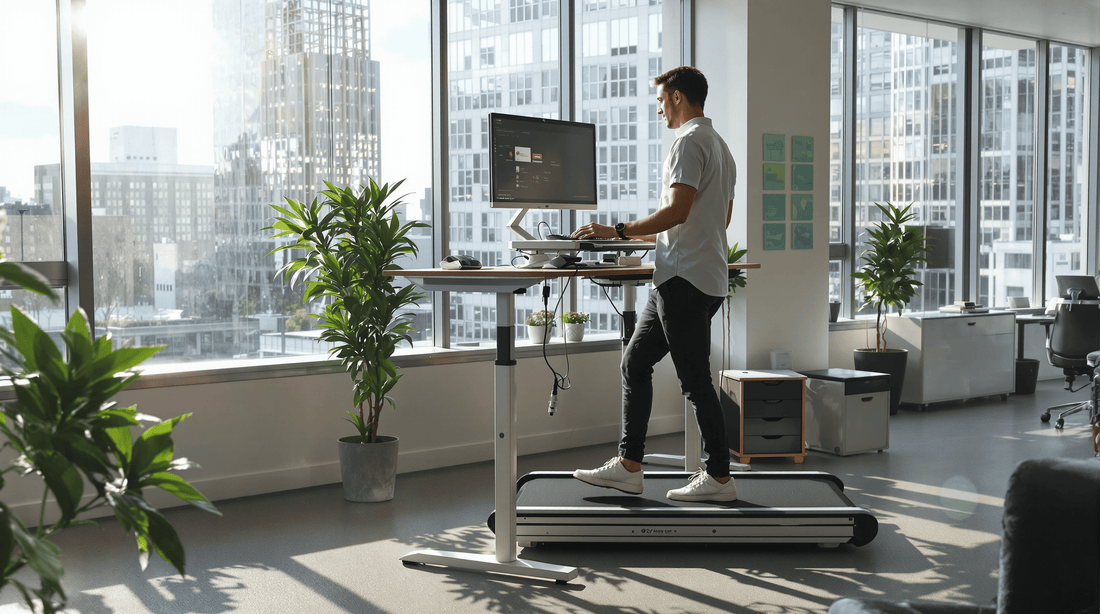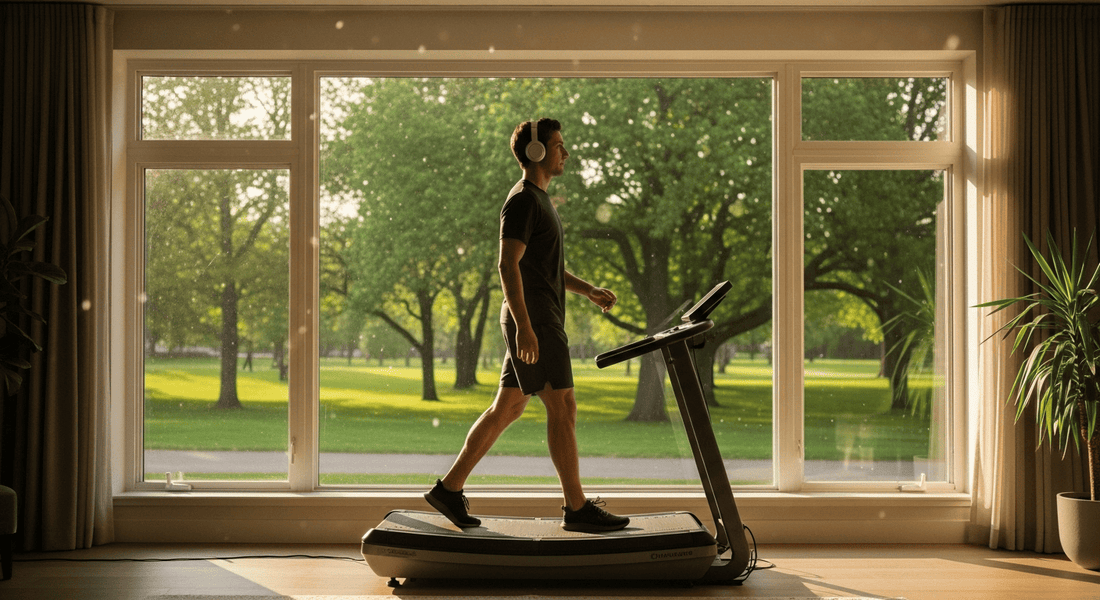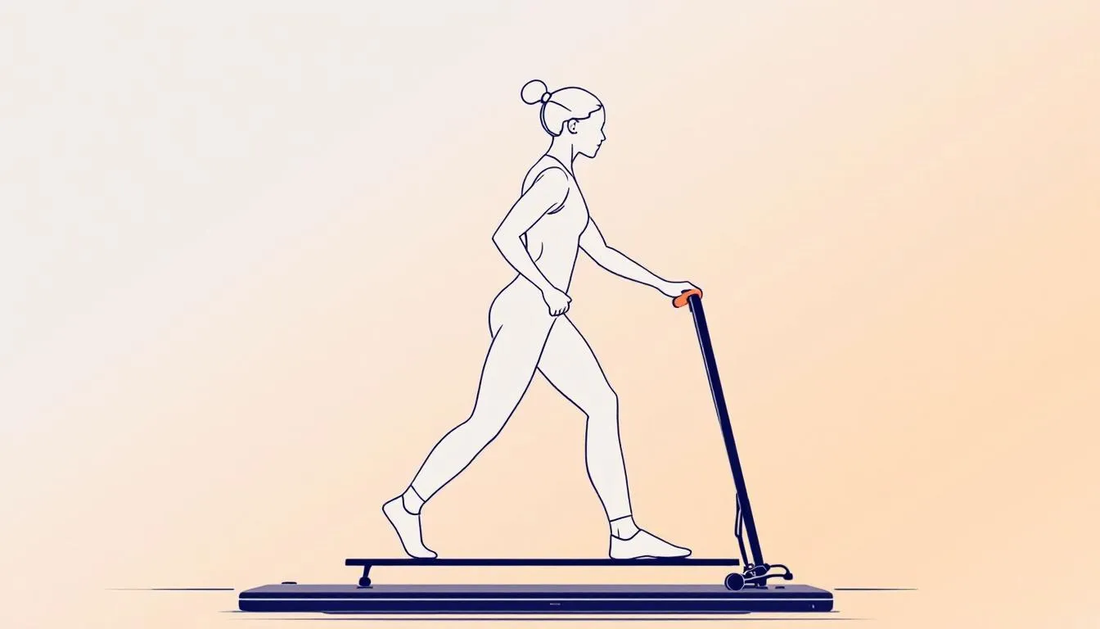Staying mobile becomes more challenging—and more important—as we age. Yet crowded gyms, harsh weather, and bulky treadmills can make regular exercise impractical for older adults. Enter the walking pad (also called an under‑desk treadmill): a compact, low‑impact device that fits neatly into a living room or spare bedroom. Walking pads are designed to save space, making them ideal for small living areas where a traditional treadmill might not fit.
But are walking pads safe and effective for seniors? In this guide, we review current research, outline safety considerations, and provide practical tips so older adults and caregivers can decide if a walking pad belongs in their wellness plan.
Quick Takeaways for Caregivers & Older Adults
-
Low‑impact exercise: Walking pads cushion joints better than outdoor pavement.
-
Speed control as low as 0.5 km/h allows gradual progression.
-
Balance aids (side rails or a nearby countertop) reduce fall risk.
-
Walking workouts: Walking workouts on pads support cardiovascular health, are easy on the joints, and can be adapted to different fitness levels, making them ideal for seniors.
-
Clinical studies show improved blood‑pressure control and mobility in seniors who use treadmill‑walking programs 3× per week.
Introduction to Walking Pads
Walking pads—sometimes called under-desk treadmills or walking treadmills—are a modern solution for staying active, especially when space is at a premium. Unlike bulky gym equipment, walking pads are designed to be compact, lightweight, and easy to move, making them perfect for apartments, small homes, or any area with limited space. Their affordable price point and simple setup mean you don’t need a dedicated home gym to enjoy the benefits of regular movement. For seniors, walking pads offer a convenient way to stay active indoors, helping to maintain mobility and independence without the risks associated with outdoor walking or crowded fitness centers.
What is a Walking Pad?
A walking pad is a specialized treadmill built specifically for walking rather than running. It features a smaller treadmill deck and a lower maximum speed, making it safer and more manageable for everyday use. Many walking pads are designed to fit seamlessly under a standing desk, allowing users to walk while working, reading, or even watching TV. This versatility makes it easy to incorporate more movement into your daily routine, whether you’re catching up on emails or enjoying your favorite show. With a walking pad, you can set a comfortable pace that suits your needs, all while benefiting from the safety and stability of a purpose-built walking treadmill.
Benefits of Using a Walking Pad
Adding a walking pad to your daily routine can deliver a wide range of health benefits. Regular use helps improve cardiovascular health, supports healthy weight management by increasing calories burned, and can boost your mood and mental clarity. Walking pads are especially effective for reducing sedentary behavior—a key factor in preventing chronic conditions like heart disease, diabetes, and obesity. Because walking pads are low-impact, they’re gentle on the joints, making them an excellent choice for seniors dealing with joint pain or mobility challenges. With the ability to enjoy treadmill workouts at home, users can stay active safely and comfortably, no matter the weather or time of day.
Why Walking Matters After 60
According to the CDC, adults 65+ should aim for 150 minutes of moderate‑intensity activity weekly. Walking:
-
Improves cardiovascular health.
-
Boosts bone density.
-
Maintains independence by strengthening leg and core muscles.
Yet outdoor walking can be limited by uneven ground, poor weather, or neighborhood safety. A walking pad solves these barriers with indoor convenience. Fitness walking indoors on a walking pad allows seniors to safely achieve their recommended activity levels, providing a low-impact cardiovascular workout that supports injury prevention and overall health.
Are Walking Pads Safe for Seniors?
What the Research Says
|
Study |
Participants |
Age Range |
Key Findings |
|
Kim et al., 2022 (J. Geriatric Cardiology) |
48 older adults |
68–82 |
12‑week treadmill‑walking at 2 km/h (about 1.2 miles per hour) reduced systolic BP by 9 mmHg. |
|
Huang et al., 2023 (Arch. Phys. Med. Rehab.) |
32 retirees |
70–79 |
Balance scores improved 15 % using slow‑speed treadmill 3×/week. |
|
American Geriatrics Society guideline, 2024 |
Meta‑analysis |
60+ |
Slow treadmill programs are low risk when speed ≤3 km/h (about 1.9 miles per hour) and hand support is available. |
Key takeaway: Controlled, slow‑speed treadmill walking is generally safe for older adults when basic precautions are followed.
Essential Safety Features
-
Speed range: 0.5–5 km/h allows fine control.
-
Emergency stop clip: Instantly halts the belt if the user slips.
-
Side rails or nearby sturdy surface: Provides balance assistance.
-
Low machine's step up height (< 5”) to reduce tripping risk.
-
Quiet motor (< 55 dB): Less startling—important for users with sensory sensitivities.
Types of Walking Pads: What’s Out There?
The market for walking pads has expanded rapidly, offering a variety of options to suit different needs and preferences. Whether you’re looking for a space-saving solution, advanced tech features, or a simple, no-frills treadmill for walking, there’s a walking pad out there for you. Understanding the different types can help you choose the best fit for your lifestyle and fitness goals.
Compact, Electric, and Manual Options Explained
-
Compact Walking Pads: These models are designed with limited space in mind. Many are foldable, allowing you to easily store them under a bed or behind a door when not in use. Despite their small footprint, compact walking pads often feature a comfortable walking surface and essential treadmill features, making them ideal for apartments or shared living spaces.
-
Electric Walking Pads: Electric models are powered by a motor and offer adjustable speed settings, making it easy to tailor your workout to your fitness level. Some electric walking pads include features like Bluetooth connectivity, LCD displays, and preset workouts to keep your exercise routine engaging. Brands like Sunny Health & Fitness are known for producing reliable, reasonably priced treadmills with user-friendly controls and solid treadmill decks.
-
Manual Walking Pads: Manual treadmills rely on your own movement to power the treadmill belt. While they are often more affordable and require no electricity, manual treadmills can be challenging to use, especially for seniors, as they demand more effort to get the belt moving and maintain a steady pace. For most older adults, an electric walking pad is a safer and more practical choice.
When shopping for a walking pad, consider your available space, budget, and desired features. Look for a sturdy frame, a comfortable walking surface, and easy-to-use controls. Many of the best walking pads offer preset workouts, Bluetooth connectivity for tracking progress, and a clear LCD display to monitor your speed and distance. With so many options available, it’s easier than ever to find a priced treadmill that fits your needs and helps you stay active at home.
Effectiveness: Health Benefits Specific to Seniors
|
Benefit |
Mechanism |
Evidence |
|
Joint relief |
Cushioned running deck absorbs shock vs asphalt |
Mayo Clinic, 2021 |
|
Improved gait |
Repetitive walking at steady pace retrains neuromuscular pathways |
PT Journal, 2020 |
|
Blood‑sugar control |
Post‑meal 10‑min walks lower glucose spikes by 13 % |
Diabetes Care, 2019 |
|
Falls prevention |
Strengthens ankle stabilizers and boosts proprioception |
Age & Ageing, 2022 |
Choosing the Right Walking Pad or Foldable Treadmill for an Older Adult
|
Feature |
Recommended Spec |
Why It Matters |
|
Min. Speed |
0.5 km/h |
Allows very slow start. |
|
Hand support |
Fold‑down rails or adjacent countertop |
Balance confidence. |
|
Weight capacity |
≥300 lbs (136 kg) |
Stability/durability. |
|
Incline |
0–5 % adjustable incline levels |
Gentle hill training without strain. |
|
Display size |
Large, high‑contrast |
Easy to read. |
Easy speed adjustments are important for seniors to safely progress their workouts.
Stand‑Out Model: **PadPace Walking Pad with Auto Incline and High Weight Capacity**
-
0.5–8 km/h speed; starts extra‑slow for beginners
-
12 % auto incline (keep off when starting; useful for progression)
-
300 lbs capacity and sturdy deck
-
FitShow app lets caregivers monitor sessions remotely
-
3‑year warranty for peace of mind
Its foldable design and compact size make it comparable to the best folding treadmill options for seniors who need a space-saving solution.
👉 Learn morePadPace Walking Pad product page
Getting Started: Step‑by‑Step Plan
-
Medical clearance: Consult a physician before any new exercise regimen.
-
Initial settings: 0.5 km/h, flat deck, 5 min duration.
-
Progression: Add 1 min per session up to 20 min; then increase speed by 0.2 km/h increments. Seniors can also take advantage of built-in workout programs on their walking pad, which guide progression and add variety to their exercise routine.
-
Balance aid: Use light fingertip contact on desk/rail until confident.
-
Footwear: Supportive walking shoes with non‑slip soles.
Sample Weekly Schedule
|
Week |
Sessions |
Speed |
Time |
|
1 |
3 |
0.5 km/h |
5 min |
|
2 |
3 |
0.7 km/h |
8 min |
|
3 |
4 |
0.9 km/h |
12 min |
|
4 |
4 |
1.1 km/h |
15 min |
Adapt based on comfort and doctor guidance. The schedule can be tailored to accommodate different fitness levels and personal comfort.
Tips for Caregivers
-
Supervise early sessions to build confidence.
-
Keep clutter clear around the walking pad.
-
Use voice‑activated assistants (Alexa/Google) to start/stop if bending is difficult.
-
Celebrate milestones (e.g., first 1 km walked) for motivation.
-
Consult a personal trainer for personalized exercise recommendations and safety tips tailored to the senior's needs.
Potential Drawbacks & How to Mitigate
|
Issue |
Mitigation |
|
Foot fatigue |
Cushioned sneakers, anti‑fatigue mat. Using a cushioned treadmill can further reduce foot fatigue and joint discomfort. |
|
Overheating |
Place a small fan nearby; stay hydrated. |
|
Monotony |
Listen to audiobooks, call a friend, or watch TV. |
FAQs
Q: Can a walking pad replace outdoor walks?
It complements but shouldn’t entirely replace varied terrain walking, which challenges balance differently.
Q: What if I rely on a walker?
Consult a physical therapist; some seniors progress from walker to slow treadmill with handrails.
Q: Is incline necessary?
Not at first. Add gentle incline only after mastering flat walking.
Q: How do walking pads compare to traditional treadmills for seniors?
Walking pads are more compact and easier to store than traditional treadmills, making them suitable for small spaces. Traditional treadmills often have sturdier frames, larger walking surfaces, and built-in support features like handrails, which can be beneficial for seniors needing extra stability. Walking pads are lighter and simpler to use, but traditional treadmills may offer more support and safety for beginners or those with mobility concerns.
Conclusion
A walking pad can be both safe and highly effective for seniors when chosen thoughtfully and used with proper precautions. Benefits include joint‑friendly cardiovascular exercise, improved balance, and greater independence. Models like the PadPace Walking Pad check the boxes for speed control, sturdy construction, and remote‑monitoring capability—making them a smart investment for older adults and their caregivers alike. Walking pads are also considered among the best treadmills for seniors because of their safety features, ease of use, and compact design.
Take the first step toward safer indoor mobility and lifelong wellness—literally—one slow, steady stride at a time.





